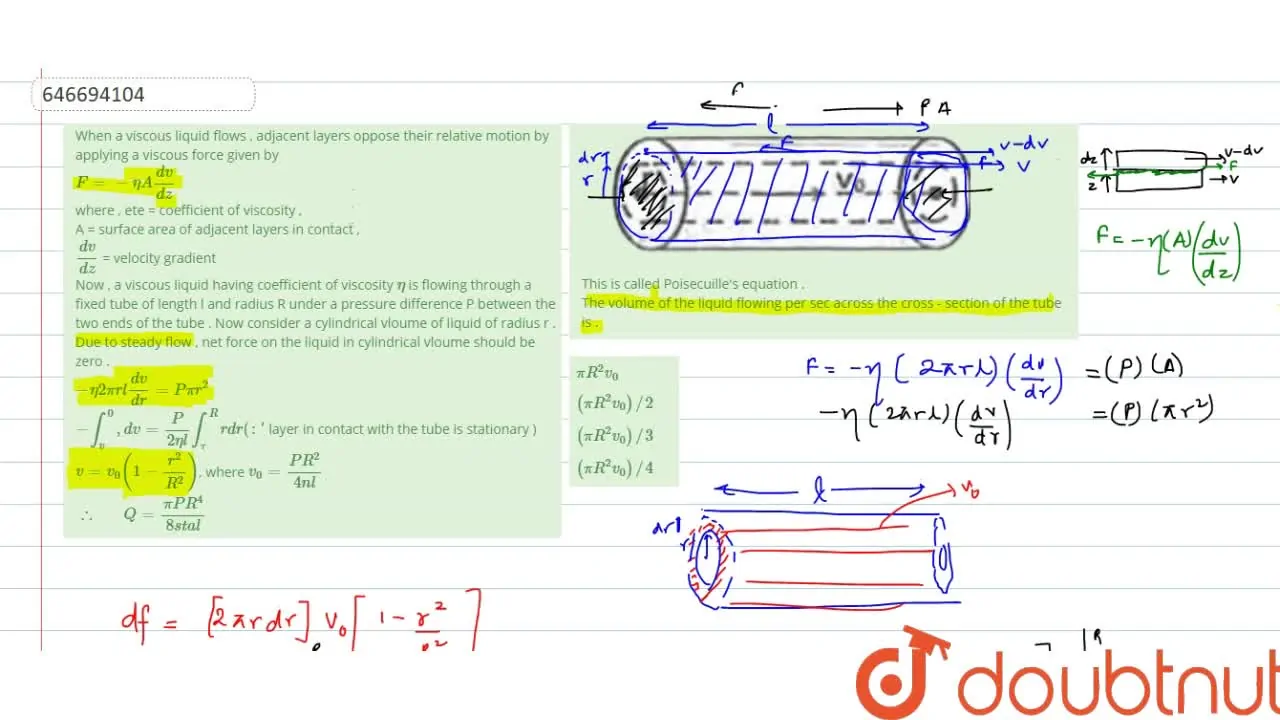When a viscous liquid flows , adjacent layers oppose their relative motion by applying a viscous force given by
F=−ηAdvdz
where , ete = coefficient of viscosity ,
A = surface area of adjacent layers in contact ,
dvdz = velocity gradient
Now , a viscous liquid having coefficient of viscosity η is flowing through a fixed tube of length l and radius R under a pressure difference P between the two ends of the tube . Now consider a cylindrical vloume of liquid of radius r . Due to steady flow , net force on the liquid in cylindrical vloume should be zero .
−η2πrldvdr=Pπr2
−∫0v,dv=P2ηl∫Rτrdr(∵ layer in contact with the tube is stationary )
v=v0(1−r2R2), where v0=PR24nl
∴ Q=πPR48stal

This is called Poisecuille's equation .
The volume of the liquid flowing per sec across the cross - section of the tube is .
πR2v0
(πR2v0)/2
(πR2v0)/3
(πR2v0)/4
The correct Answer is:B
Step by step video & image solution for When a viscous liquid flows , adjacent layers oppose their relative motion by applying a viscous force given by F = - eta A (dv)/(dz) where , ete = coefficient of viscosity , A = surface area of adjacent layers in contact , (dv)/(dz) = velocity gradient Now , a viscous liquid having coefficient of viscosity eta is flowing through a fixed tube of length l and radius R under a pressure difference P between the two ends of the tube . Now consider a cylindrical vloume of liquid of radius r . Due to steady flow , net force on the liquid in cylindrical vloume should be zero . - eta 2pirl (dv)/(dr) = Ppir^(2) - int _(v)^(0),dv = P/(2 eta l) int_(tau)^(R) rdr ( :' layer in contact with the tube is stationary ) v = v_(0) (1- (r^(2))/(R^(2))), where v_(0) = (PR^(2))/(4nl) :. " " Q = (piPR^(4))/(8sta l) This is called Poisecuille's equation . The volume of the liquid flowing per sec across the cross - section of the tube is . by Physics experts to help you in doubts & scoring excellent marks in Class 12 exams.
Similar Questions
When a viscous liquid flows , adjacent layers oppose their relative motion by applying a viscous force given by F = - eta A (dv)/(dz) where , ete = coefficient of viscosity , A = surface area of adjacent layers in contact , (dv)/(dz) = velocity gradient Now , a viscous liquid having coefficient of viscosity eta is flowing through a fixed tube of length l and radius R under a pressure difference P between the two ends of the tube . Now consider a cylindrical vloume of liquid of radius r . Due to steady flow , net force on the liquid in cylindrical volume should be zero . - eta 2pirl (dv)/(dr) = Ppir^(2) - int _(v)^(0),dv = P/(2 eta l) int_(tau)^(R) rdr ( :' layer in contact with the tube is stationary ) v = v_(0) (1- (r^(2))/(R^(2))) , where v_(0) = (PR^(2))/(4nl) :. " " Q = (piPR^(4))/(8sta l) This is called Poisecuille's equation . The viscous force on the cylindrical volume of the liquid varies as
View SolutionAccording to Newton, the viscous force acting between liquid layers of area A and velocity gradient ΔvΔz is given by F=−ηAdvdz, where η is constant called coefficient of viscosity . The dimensional formula of its
02:12View SolutionAccording to Newton, the viscous force acting between liquid layers of area A and velocity gradient ΔvΔz is given by F=−ηAdvdz, where η is constant called coefficient of viscosity . The dimensional formula of its
02:12View SolutionThe viscous force acting between two layers of a liquid is given by F/A=eta(dv)/(dz) . This F/A may be called
01:25View SolutionAccording to Newton, the viscous force acting between liquid layers of area A and velocity gradient (Delta v)/(Delta z) is given by F= - eta A (dv)/(dz) , where eta is constant called coefficient of viscosity. The dimensional formula of is
02:12View SolutionThe viscous force acting on adjacent layers of liquid is
04:19View SolutionAccording to Newton, the viscous force acting between liquid layers of area A and velocity gradient ΔvΔz is given by F=−ηAdvdz, where η is constant called coefficient of viscosity . The dimensional formula of its
02:12View SolutionAccording to Newton, the viscous force acting between liquid layers of area A and velocity gradient ΔvΔz is given by F=−ηAdvdz, where η is constant called
01:34View Solution


